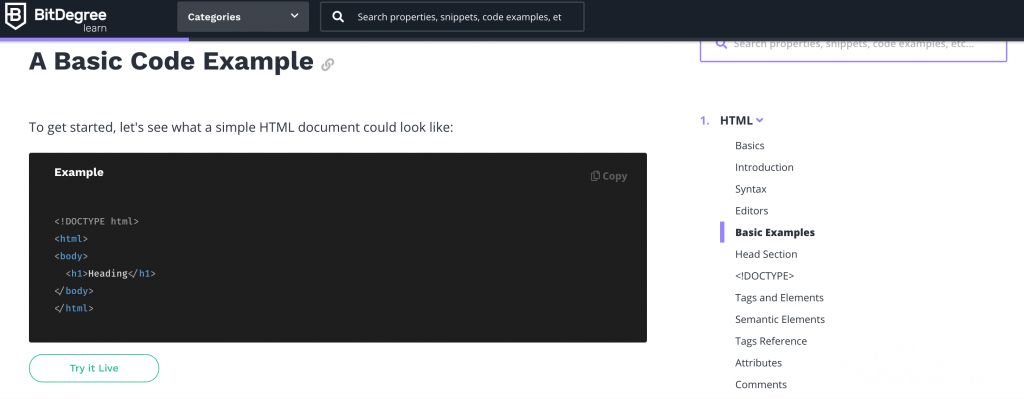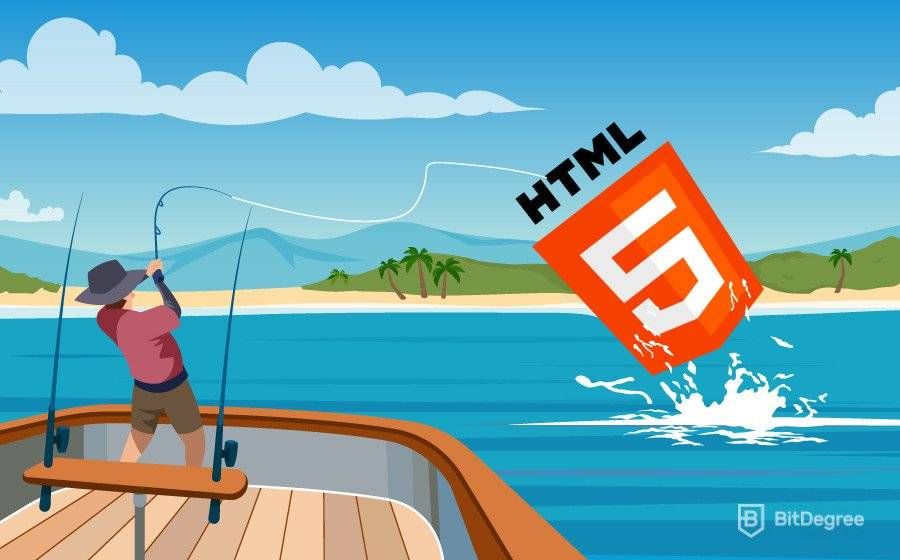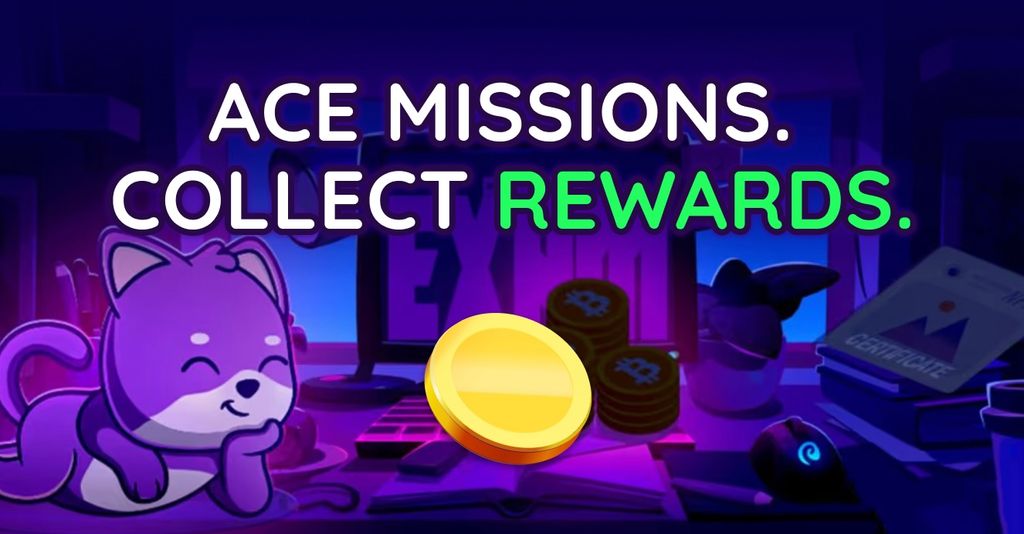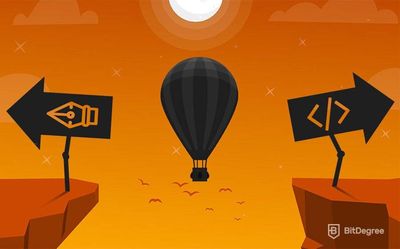Ace quick missions & earn crypto rewards while gaining real-world Web3 skills. Participate Now ! 🔥
HTML, or Hypertext Markup Language, is one of the most common forms of code in the world. It is used on pretty much every single web page in existence, and it allows web designers to present text, images, videos, and other content in a clear, concise manner.
Naturally, many beginners choose this language to learn first, yet find the difficulty to understand what is the best way to learn HTML. If you want to become a front-end web developer, learning HTML is essential.
Luckily for you, there are hundreds of websites out there teaching you HTML basics that will allow you to build a simple HTML page. Some of the best ones are edX, Coursera, and Udacity!
However, these websites don’t always teach you the best or most efficient way of how to learn HTML. They don’t always teach the most up to date version of the language, and they don’t always teach you everything that you need to know.
Table of Contents
- 1. What Is HTML & Why Should I Learn It?
- 1.1. How Does HTML Work?
- 1.2. HTML & CSS Go Hand in Hand
- 1.3. Why Learn HTML?
- 2. Who Should Learn HTML?
- 2.1. Aspiring front-end developers
- 2.2. People who work in content management or other internet related fields
- 2.3. Website/blog owners
- 3. What Is The Best Way To Master HTML?
- 4. What Other Resources Should I Use?
- 4.1. YouTube Videos
- 4.2. Language Reference Guides
- 4.3. Online Forums
- 5. Free Resources vs Paid Resources
- 5.1. Paid Resources
- 5.2. Free Resources
- 6. How Can I Practice Writing HTML Code?
- 7. So, What Is The Best Way to Learn HTML?
What Is HTML & Why Should I Learn It?
HTML is incredibly widespread. It is primarily used by front-end web developers to style and present web content in a readable manner. If you want to be a front-end developer, this markup language should be the first one on your list.
Latest Deal Active Right Now:Take advantage of this special Udacity coupon code & access selected Udacity courses for free! Learn new skills & develop your career at zero cost.
How Does HTML Work?
One of the primary features of the HTML language is its use of tags to style text and other visual elements. It is relatively easy to learn HTML tags when you notice that they have a few features which are clear and universal:
- Most HTML tags begin with an opening tag, <> and finish with a closing tag, </>. However, there are a few elements that don't need a closing tag.
- In most cases, the content that we want to be defined by the tags goes between the opening and closing tags. Sometimes things are included within the opening tag.
HTML & CSS Go Hand in Hand
Although it can be used on its own, it is very rare for someone to use HTML by itself. In most cases, HTML is used to define the general layout and look of a webpage, while a different language, CSS, is used to style the content.
The main reason for this is because HTML is limited in what it can do. Using HTML you have limited styling of text and image properties. You can define what type of text you want to include, you can make tables and lists, and you can embed things like images and videos.
However, it is difficult to change things like the font, text color, and the exact positioning of elements within a web page. Therefore, it is recommended to learn HTML and CSS together.
Why Learn HTML?
HTML is an essential language for anyone who is aspiring to become a front-end web developer.

This markup language is used on pretty much every web page in existence, and it makes it simple to create engaging content in a way that web browsers can understand, and it is simple to learn and easy to use. Some of the other reasons why you should seriously consider learning HTML include:
- It is simple. If you have zero coding knowledge, but you would like to become some sort of coder or programmer, it is best to learn HTML in the first place. It is easy to learn and use, it will provide a good introduction to coding, and it will help you get your head around basic coding concepts.
- It can help you find a job. Programming and coding, in general, are in-demand skills which companies throughout the world are looking for. Simply having some knowledge of HTML basics to put on your resume can make you more employable and can help you find a job.
- It could result in a promotion or pay rise. As said before, coding skills are in high demand in the modern world. Even the most basic programmers are charging up to $100 per hour, which means that having programming skills could help you get your next promotion or pay rise.
As you can see, there are plenty of reasons why HTML is a great language to learn.
Who Should Learn HTML?
HTML can provide a basic introduction to coding, that it could help you find work, and that it could provide the basis for a pay rise. In line with that, here are three groups of people who should think seriously about learning HyperText Markup Language:
Aspiring front-end developers
HTML, CSS, and JavaScript form the basis of front-end web development. This means that if you are serious about becoming a front-end developer, HTML has to be your second nature. The fact that it is simple and easy to learn means that it is often the first language that aspiring developers dabble in.
People who work in content management or other internet related fields
Anyone who works in content management, writing, or anything else related to digital content should learn HTML immediately because it could benefit them greatly.

For example, let’s say that you need to write articles for a client’s website, but that you have to publish them directly into the website.
Sure, you could probably manage without knowing HTML - content management systems like WordPress and Wix have made sure of that - but it will be a lot easier if you understand how to format a simple HTML page.
Website/blog owners
If you own and run your website or blog, you may find it very beneficial to learn the basics of HTML. Doing so gives you more flexibility when it comes to formatting both your website and your content, potentially saving you money.
After all, web developers are expensive, and it could cost you a small fortune to employ a developer for even a few hours. You would be much better off if you were able to make small HTML changes by yourself.
What Is The Best Way To Master HTML?
Different people will be more suited to different methods of teaching, and the best way to learn HTML for one person won’t necessarily be the best way for another.
Keep this in mind as you read the following couple of paragraphs.
Now, for most people, the best way to learn HTML is through an interactive online course. As a language that has been developed for use on the internet, it makes sense to use the internet to learn the basics of HTML. Some of the features of online HTML courses make them the best way to learn include:
- They are fun and engaging. This means that they make it easier to stay motivated, which reduces the risk of you giving up before you have finished your course.
- They cover the basics first, meaning that you aren’t wasting your time learning irrelevant information at the start.
- Many online HTML courses allow you to write code directly in your browser as you learn, teaching you good habits from the beginning.
If you think that you would like to learn HTML and that an online HTML tutorial would be a good place to start, then check out the courses on the BitDegree platform. The Interactive Coding for Beginners HTML course is perfect for people who are on the way to becoming front-end developers.
It teaches both HTML and CSS alongside each other, it will show you how to use them together, and it will also introduce you to the basics of responsive web design.
If you’re a little short on time and just want to get a brief overview of HTML, you could start with the HTML Coding For Beginners Course. This course will teach you the basics of HTML coding, along with some of the most important syntax, in under an hour of video tutorials.
Alternatively, you could head to Udacity and take their HTML and CSS course that will provide you with knowledge of both languages at the same time. If you're confident enough to learn two languages at the same time and want to take it slow, head to Coursera and take their Introduction to HTML course.
What Other Resources Should I Use?
When searching the internet for the answer to how to learn HTML, you will uncover a lot of different resources. Some of these are free, some of them are paid (more on that in the next section), but the single common theme is that they all claim to be the best.
However, a lot of these resources are outdated. This doesn’t mean that there aren’t good ones out there, but you should be careful. Consider the following things to help you uncover HTML basics alongside your main course:
YouTube Videos
Watching videos that touch on difficult or confusing concepts can be a great way to learn HTML and get your head around things that you’re struggling with.

If you find yourself having trouble with a specific concept - or if you would simply like a deeper explanation than your course offers - search for the answers on YouTube.
Language Reference Guides
Language reference guides are a great resource that you can use to discover new syntax, to refresh your memory on old syntax, or to learn pretty much anything else about a programming language.
Check out BitDegree's HTML reference guide to learn all about the tags and elements you can use. Here you can also find code snippets and try them out live in the free code editor. 
Online Forums
If you can’t find the answers to your questions anywhere else, you can always ask other people who have a better understanding of how to learn HTML than you do.
Online forums and chat boards are a great resource for people who are trying to learn a programming language like HTML. Use them to ask questions, participate in discussions, and to discover the solutions to even your most difficult problems.
Free Resources vs Paid Resources
Now that we’ve covered the types of resources available to HTML learners, it’s time to have a quick look at a debate that has grown in magnitude over the past few years - free resources vs paid resources.
It is quite simple to find free programming courses and other resources on the internet, but are they worth using? Or should you be paying for your courses to make sure that you’re learning everything you can?
Paid Resources
Historically, people have had to pay to learn HTML and access to high-quality learning materials. There are a variety of such resources on the internet, ranging from paid tutorials to paid tutors and code helpers. One of my personal favorite paid learning platform is edX.
Pros of Paid Resources:
- You will be learning from industry professionals who know about the things that they are teaching. This can help reduce the risk of learning incorrect information or poor habits.
- When you pay for something, you’re more likely to use it. This will help you stay motivated, and may result in better results from the learning process.
- You will probably find that paid courses are very well organized and that they contain all of the relevant information.
Cons:
- Not everyone can afford them.
- Some people want to delve into coding without committing themselves. Paying to learn HTML can feel like a commitment to some.
- Paid courses don’t always provide the answers to simple questions quickly and efficiently. If you want to learn how to do one specific thing, look for free resources.

- Easy to use with a learn-by-doing approach
- Offers quality content
- Gamified in-browser coding experience
- Free certificates of completion
- Focused on data science skills
- Flexible learning timetable

- High-quality courses
- Nanodegree programs
- Student Career services
- Nanodegree programs
- Suitable for enterprises
- Paid certificates of completion

- A wide range of learning programs
- University-level courses
- Easy to navigate
- University-level courses
- Suitable for enterprises
- Verified certificates of completion
Free Resources
The rise of alternative income sources like internet advertising and ‘freemium’ courses means that a huge number of free courses and other free resources have made their way online in recent years. One of the best-known ones is Udemy.
Pros:
- They require no financial commitment, which is great for people with little money.
- If you don’t like a free resource, you can just choose another one without losing anything from a financial perspective.
- Free resources are accessible to anyone with an internet connection and a little bit of time. This means that people can learn HTML basics without committing to a course.
Cons:
- Free resources can be of lower quality than paid resources. This is because they are sometimes created by people who are less than professionals themselves. They can contain incorrect information, and they can miss important details.
- There are so many free resources out there that it can be super hard to find the ones which are right for you.
- Sometimes it’s worth paying someone for a simple answer, rather than having to wade through pages of forum replies or Google search results.
As you can see, both free and paid resources have their positive and negative aspects. If you are serious about becoming an HTML professional, we would recommend paying for a course (or apply for a scholarship so that the paid course fee would be funded for you).
However, if you want to discover the language without committing, free resources can help you do that.
How Can I Practice Writing HTML Code?
Once you have decided to learn HTML and have mastered the basics, everything comes down to practice. The best way to learn HTML is by practice and you can do that by creating your website. There are a few options for this:
- Try to create your own site by using a code editor, add the necessary CSS/JavaScript to make it work. This is featured as well in the Interactive HTML & CSS course, where you are building your website step by step.
- Use a drag and drop website builder that eliminates the need for more complicated languages like JavaScript or PHP, and focus on the HTML syntax.
You can check this best free website builder guide to find some options that won't hurt your wallet.
If you think that you are not ready for a website yet, you can further find ways of how to learn HTML and advance your skills by doing small challenges:
- Try the code examples in BitDegree Learn and tinker them to your liking.
- Participate in Code Playground and submit your creations.
- Find interesting pieces of websites and try to copy/recreate them yourself.
- Participate in coding challenges.
- Try to solve HTML issues on StackOverflow.
- Learn CSS and see how it enhances your HTML skills.
- Take one of the best-rated courses on edX!
Once you're ready for more advanced challenges, you can start taking freelance jobs or, if you learn CSS and JavaScript along the way, even start trying to find a proper job as a front-end developer. Whatever method you choose, remember this - if you don’t practice a skill, you will lose it.

Did you know?
Have you ever wondered which online learning platforms are the best for your career?
So, What Is The Best Way to Learn HTML?
HTML is the language of the internet. If you are looking for how to learn HTML, you should start with an online course that will explain to you how this language works in a structured and organized way. Once you have the basics, or if you struggle along the way, keep BitDegree's HTML reference by your side.
A lot of people choose to use paid resources when learning a programming language for the first time, but this isn’t essential. Free courses can be useful as well, especially if you aren’t sure if you want to become a web developer or programmer.
Remember, if you want to learn HTML properly, you need to practice, practice, and practice some more. Good luck, have fun, and welcome to the world of HTML!











